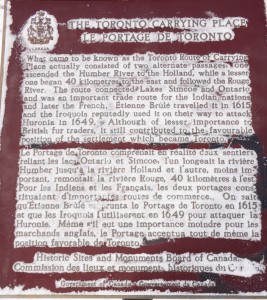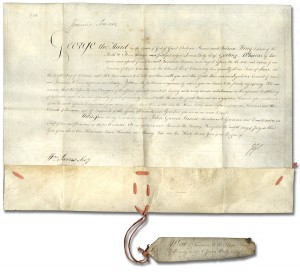The Toronto Purchase: The lands comprising modern-day Baby Point were purchased from the Mississauga First Nations as part of the Toronto Purchase in 1787. Following the Treaty of Paris in 1763 that marked the end of the Seven Years’ War between France and Great Britain, and the fall of New France, the territory comprising modern day Ontario was ceded from the French to the British (renamed British North America and later Upper Canada). The area was sparsely populated with the largest settlement being Detroit which had been founded by the French.
In the years after the Americans defeated the British during the American Revolutionary War in 1783 (capped by another Treaty of Paris) about 10,000 Loyalists fled for Upper Canada, where they began to settle on land recognized by the British Crown as ‘Indian Land’. The settlers’ lack of legitimate land created challenges for Lord Dorcester who arrived in Quebec in 1786 just as British North America was being split into Upper and Lower Canada. John Graves Simcoe was appointed the first Lieutenant-Governor of Upper Canada in 1791. After deciding on the Bay of Toronto as the site of the new province’s capital, Lord Dorcester arranged to purchase much of the land comprising modern-day Toronto, including modern-day Baby Point from the Mississauga. In 2010, the Government of Canada agreed to a $145 million dollar settlement resulting from a land claim initiated by the Mississauga in 1986 disputing the terms of the purchase.
Land Petitions and United Empire Loyalists: As a flood of refugees migrated north after being driven from their homes in America following the American Revolutionary War, the Government of Upper Canada began granting land to Loyalists who fought on the side of the British or simply pledged their loyalty to King George III. Loyalists were conferred the title of United Empire Loyalist (UE) and their children were conferred the title of Sons of Empire Loyalist (SUE) or Daughters of Empire Loyalist (DUE). One such Loyalist was John Lawrence. Lawrence had been imprisoned during the American Revolution as a traitor. His cellmate was none other than John Graves Simcoe, captured during the war. The two became friends and Simcoe approved Lawrence’s petition for a land grant in 1797. Lawrence’s land grant included the property from the modern day Old Mill to Dundas street. It came with the obligation to construct a grist mill on an island on the Humber River. Lawrence died the following year in 1798 just as the new settlement began to gain economic importance. It remains unclear if the grist mill was ever built.
 James Baby Acquires the Lands Comprising Modern-Day Baby Point:
James Baby Acquires the Lands Comprising Modern-Day Baby Point:
In 1820, (James) Baby purchased 114 acres of land (part of Lots 2 and 3 on the Humber, 2nd Concession from the Lake) that comprised what later became known as Baby Point. Born in Detroit in 1763 (at the time under the British), Baby’s ancestors had emigrated to Quebec from France as settlers and fur traders in the mid-17th century. The land he purchased had changed hands several times after the initial short lived grant to the Loyalist, John Lawrence. Baby purchased it after he was appointed Inspector General of Upper Canada in 1815 and moved to York (later Toronto) to take up his appointment. He never lived on the property, preferring to reside in downtown York on Market Street (today Wellington St., between Church and Peter Sts.), but he frequently visited it for recreational purposes, especially to fish with his sons in the Humber River.
James Baby held many important government appointments; among others, he was a member of the Legislative and Executive Councils of Upper Canada; a member of the Land Committee; deputy General Superintendent of the Bureau of Indian Affairs; and a member of the Commission to determine the boundaries of Upper and Lower Canada. He belonged to the so-called Family Compact, an ultra-conservative clique of British colonial administrators who ran Upper Canada. As a native-born French-Canadian, Baby was an anomaly in the group. Nevertheless, he was staunchly loyal to the British for 40 years, anglicized his name to James, and voted with the group to oppose progressive legislation, such as the Act Against Slavery put forward by John Graves Simcoe in 1793. The opposition resulted in a gradual phase-out until its complete abolition across the British Empire in 1833, rather than an immediate end to slavery. Baby himself owned a black slave named Thérèse whom he had purchased from his brother who had inherited her from their father, Jacques Dupéron Bâby (d. 1789). She was emancipated in 1803, and lived with Baby, a widower, in his house in York until her death in 1826. Baby himself died in 1833 and was survived by his daughter and 5 sons. His wife Elizabeth Abbott had died tragically during the war of 1812 in Sandwich (Windsor) where the Baby family had been forced to relocate after the Americans took Detroit and where the Baby family mansion is a historical landmark today.
(Image: Portrait of Jacques (James) Baby, public domain)
(Image: Appointment of Jacques (James) Baby to the Legislative Council for Upper Canada,1792. From the Jacques Duperon Baby family fonds, F 2128, MU 18, Archives of Ontario. Reproduced by permission.)
Mills of the Humber River: The area surrounding the Humber River began to flourish in the 1800s as local economies grew around the mills. The first King’s Mill (built 1793 at the site known today as the Old Mill) burned to the ground in 1803. The last and grandest King’s Mill (same site as first mill) was built in 1848 but also burned in 1881. At its peak in the 1840s, the surrounding village of Milton Mills was home to about 100 people. The remains of the grist mill for grinding grain, could be seen until 2000 when they were dismantled and replaced with the current hotel whose foundations were modeled after the mill and even used some of the original stones.
Cooper’s Mill was built in 1807 at the end of Old Dundas Rd. and today is the site of an apartment building across from Lambton House, an inn established in 1848 and used until 1988. William Howland bought the mill in 1851 and changed the name of the mill and village (pop. ~500) to Lambton in honour of John Lambton, a former Governor General of Canada. Howland himself was elected to the provincial Legislature in 1858 and later became a Father of Confederation and the second Lieutenant-Governor of Ontario. Old Dundas Rd. continued across a bridge spanning the Humber River and the inn was used by weary travelers on their way to far-away places like London and Hamilton.
 The Bent Railway: The ill-fated Bent Railway line was built in 1891 but was an economic disaster that lasted less than two years. The tracks on the Humber loop passed almost directly where the Baby Point roundabout at the intersection of Humbercrest and Baby Point Rd. sits today. The track continued just to the east of Humbercrest to the north of Baby Point Rd. The closest station was to the west of the intersection of Jane and St. Clair Streets. Another part of that line passed through the Junction neighbourhood. When the tracks were removed in 1983 a new neighbourhood was constructed surrounding the Baby estate to the north, south and east.
The Bent Railway: The ill-fated Bent Railway line was built in 1891 but was an economic disaster that lasted less than two years. The tracks on the Humber loop passed almost directly where the Baby Point roundabout at the intersection of Humbercrest and Baby Point Rd. sits today. The track continued just to the east of Humbercrest to the north of Baby Point Rd. The closest station was to the west of the intersection of Jane and St. Clair Streets. Another part of that line passed through the Junction neighbourhood. When the tracks were removed in 1983 a new neighbourhood was constructed surrounding the Baby estate to the north, south and east.
(Image: Plaque about the Toronto Carrying Place/Le Portage de Toronto)

